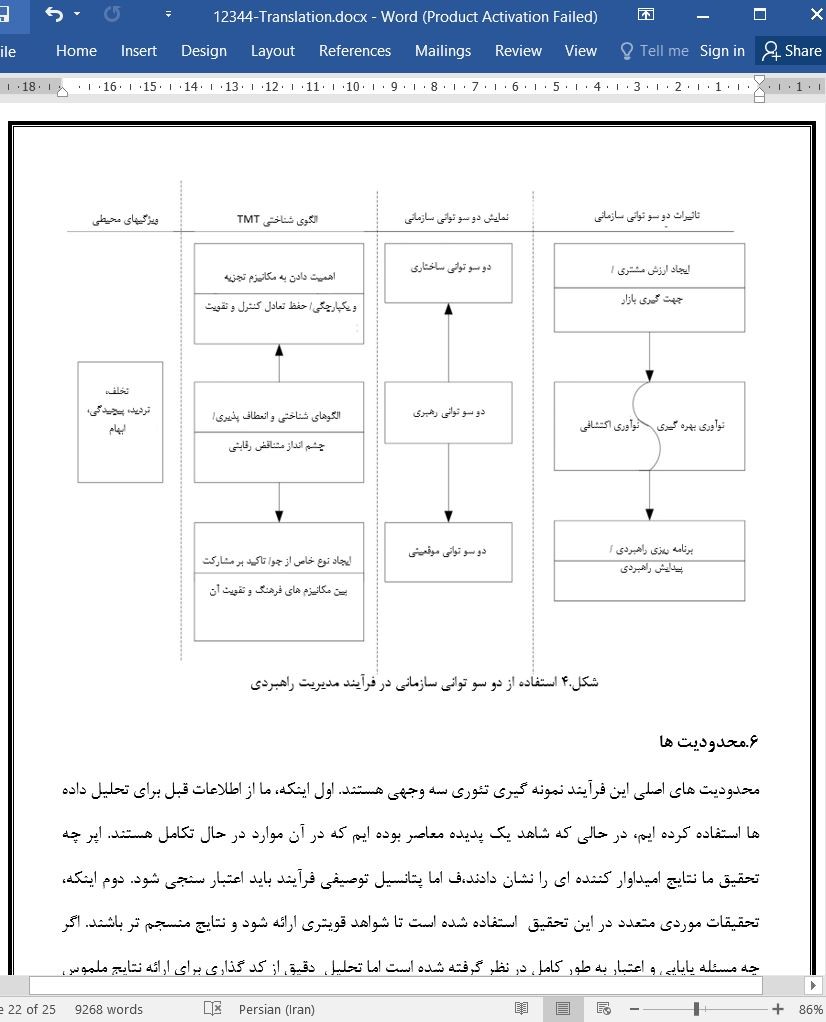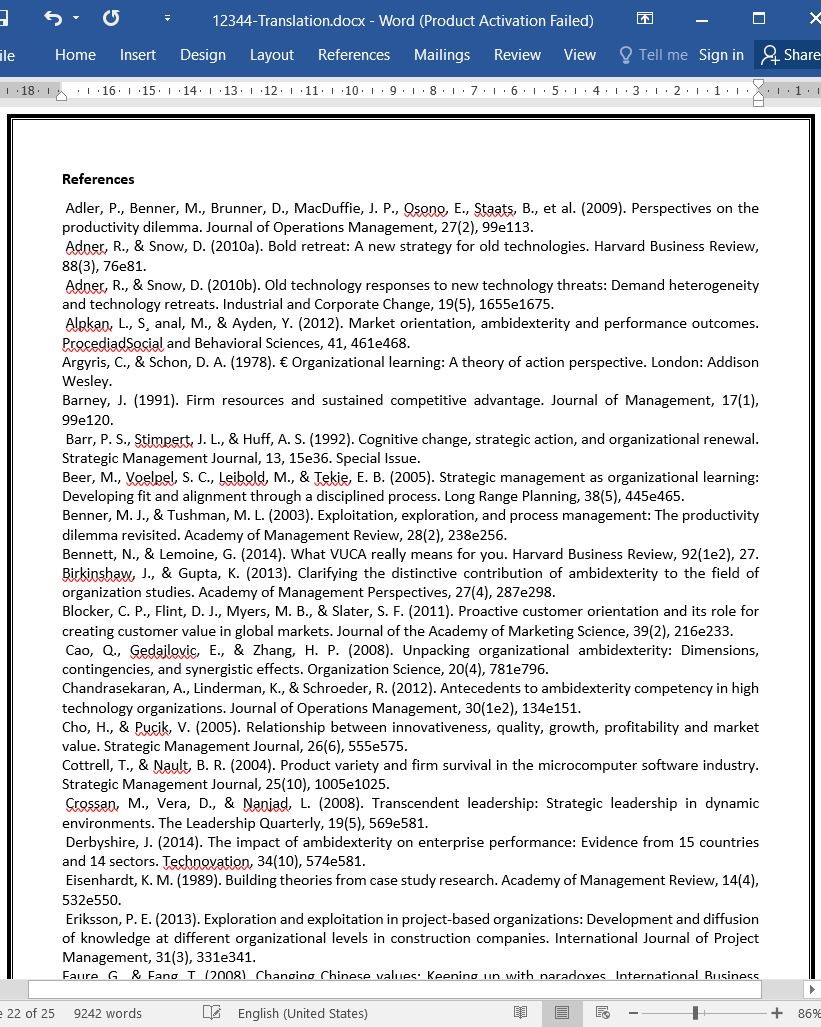
استفاده از دو سو توانی سازمانی در مدیریت راهبردی در محیط "VUCA"
چکیده
شرکت های مجهز به تکنولوژی پیشرفته با نیاز به بهره گیری و اکتشاف و بخصوص در بازار رقابتی امروز همراه با تردید، سرپیچی، پیچیدگی و ابهام مواجه می شوند. اگرچه اجماع نظر کلی در مورد رابطه بین دو سو توانی و عملکرد شرکت وجود دارد، اما تحقیقات کمی به مکانیزم چگونگی استفاده از این مفهوم در فرآیند مدیریت راهبردی اشاره کرده اند. با در نظر گرفتن فرضیه تغییر، در این تخقیق چشم اندازهای مختلف در مورد ماهیت دو سو توانی سازمانی و عملکرد آن در فرآیند مدیریت سازمانی در نظر گرفته شده است. با انجام یک تحقیق قیاسی از دو شرکت پیشرفته معروف در چین، مدلی برای انعکاس عملکرد دو سو توانی سازمانی ارائه شده است که در آن یک الگوی شناختی از مدیریت ارشد نقش مهمی در توانایی تشریح شده سازمان ایفا می کند. همچنین، این تحقیق از طریق گسترش نوآوری از چشم انداز تقاضا محور در زنجیره افزایش ارزش مشتری به افزایش وسعت ادبیات کارآفرینی کمک می کند. این تحقیق با انجام تحلیل دقیق از مکانیزم دو سو توانی سازمانی، اطلاعات جدیدی را بر ادبیات مدیریت راهبردی اضافه می کند که در محیط بازار نوسانی اعمال می شود.
6.محدودیت ها
محدودیت های اصلی این فرآیند نمونه گیری تئوری سه وجهی هستند. اول اینکه، ما از اطلاعات قبل برای تحلیل داده ها استفاده کرده ایم، در حالی که شاهد یک پدیده معاصر بوده ایم که در آن موارد در حال تکامل هستند. اپر چه تحقیق ما نتایج امیداوار کننده ای را نشان دادند،ف اما پتانسیل توصیفی فرآیند باید اعتبار سنجی شود. دوم اینکه، تحقیقات موردی متعدد در این تحقیق استفاده شده است تا شواهد قویتری ارائه شود و نتایج منسجم تر باشند. اگر چه مسئله پایایی و اعتبار به طور کامل در نظر گرفته شده است اما تحلیل دقیق از کد گذاری برای ارائه نتایج ملموس تر مورد نیاز است. این عامل می تواند در تحلیل های کمیتی آینده در نظر گرفته شود. در نهایت، این تحقیق به بررسی شرکت های بزرگی می پردازد که روشهای جدید ایجاد ارزش مشتری را به موازات فرآیندهای ابتکاری معرفی کرده اند. در نتیجه، اطلاعات بدست آمده از تجارب این شرکت ها نمی تواند برای تمام شرکت ها و موقعیت ها در نظر گرفته شود. بنابراین، شیوه های موثر تحلیل های آینده که فراتر از محدودیت های این تحقیق هستند (ایسنهارت 1989) شامل اختلاف در موفقیت معرفی دو سو توانی، اندازه و قدمت سازمان ها می باشند و اختلافات بیشتر در موقعیت صنعتی را در بر می گیرند.
Abstract
High tech organizations confront dual demands of exploration and exploitation, particularly in today’ s competitive environment marked by a trend of volatility, uncertainty, complexity, and ambiguity. Although there is general consensus about the relationship between ambidexterity and firm performance, few studies have probed into the mechanism of how it is applied in the strategic management process. Considering the premise of environmental change, this research considers a multilevel perspective on the nature of organizational ambidexterity and its functioning in the whole strategic management process. Through a comparative case study of the two most famous high tech companies in China, a model is provided to reflect the functioning of organizational ambidexterity where a cognitive pattern of top management teamsplays a critical role in the ability that the organizations demonstrate. This research also contributes to the literature of entrepreneurship by extending innovation from a demand-side perspective, where the core of product/market exploration/exploitation activities could be expanded into customer value creation. Undertaking a careful analysis of the mechanism of organizational ambidexterity, this research sheds new light on the literature of strategic management that operates in a more turbulent environment.
6. Limitations
The main limitations of this theoretical sampling process are threefold. First, we use retrospective data for analysis, while we observe a contemporary phenomenon in which the cases are still evolving. Although our exploration offers promising results, the descriptive potential of the process needs to be further validated. Second, multiple case studies are used in this research to provide more compelling evidence and produce more robust conclusions. Although the problem of reliability and validity were taken into full consideration, a deep analysis of encoding is required to generate more concrete results. This could be realized to employ more quantitative analyses in the future. Finally, this study deals with large, established companies that introduce creative ways of customer value creation in parallel to their core innovation processes. As a result, insights from their experiences may not hold for all types of companies and settings. Promising avenues for further analysis that go beyond the scope of this research (Eisenhardt, 1989) could thus include variations in the success of introducing organization ambidexterity, in the size and age of companies, and further variations in the industry setting.
چکیده
1. مقدمه
2. پیش زمینه تئوری
2.1 از چشم انداز موقعیت یابی رقابت تا چشم انداز تقاضا محور
2.2 دو سو توانی سازمانی
2.3 دو سو توانی یازمانی و موفقیت شرکت
3. روش تحقیق و اطلاعات
3.1 انتخاب موقعیت ها
3.2 گردآوری اطلاعات
4. تحلیل داده ها
4.1 طرح کار شرکت علی بابا و تنکنت
4.2 نمایش دو سو توانی سازمانی
4.3 مکانیزم دو سوتوانی سازمانی
5.بحث و مساعدت ها
6.محدودیت ها
منابع
Abstract
1. Introduction
2. Theoretical background
2.1. From the competitive positioning view to the demand-side perspective
2.2. Organizational ambidexterity
2.3. Organizational ambidexterity and firm success
3. Methodology and data
3.1. Case selection
3.2. Data collection
4. Data analysis
4.1. Roadmaps of Alibaba and Tencent
4.2. Display of organizational ambidexterity
4.3. Mechanism of organizational ambidexterity
5. Discussion and contributions
6. Limitations
References
- اصل مقاله انگلیسی با فرمت ورد (word) با قابلیت ویرایش
- ترجمه فارسی مقاله با فرمت ورد (word) با قابلیت ویرایش، بدون آرم سایت ای ترجمه
- ترجمه فارسی مقاله با فرمت pdf، بدون آرم سایت ای ترجمه



